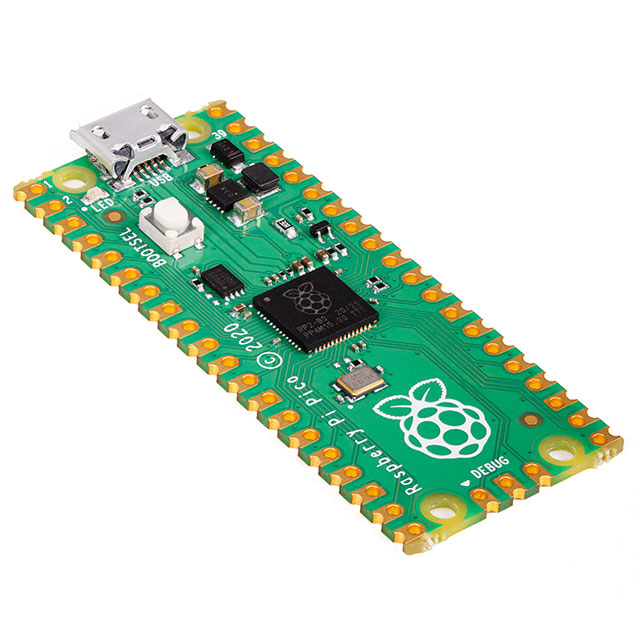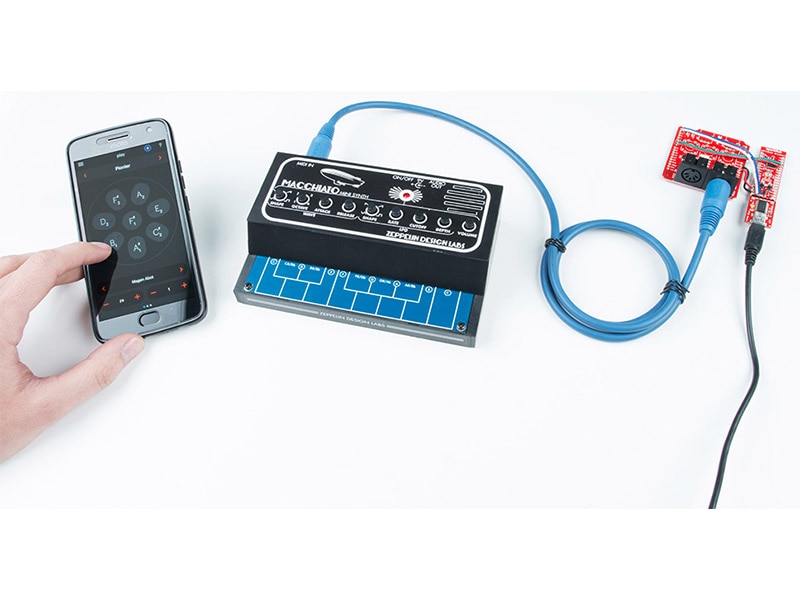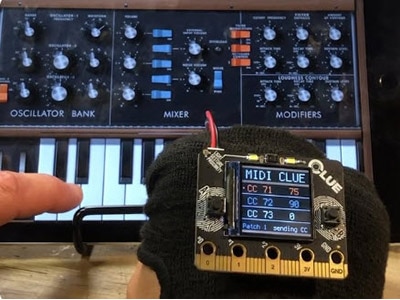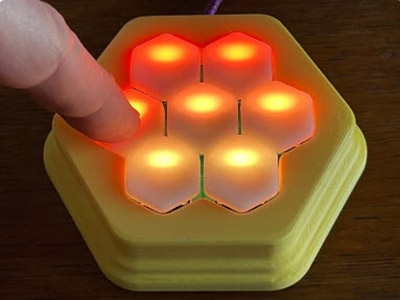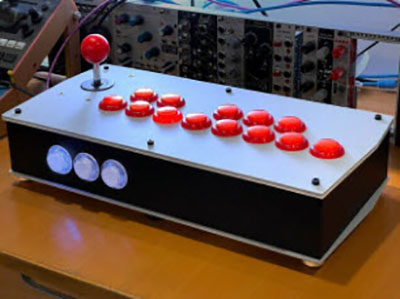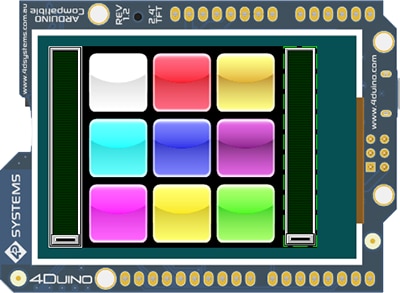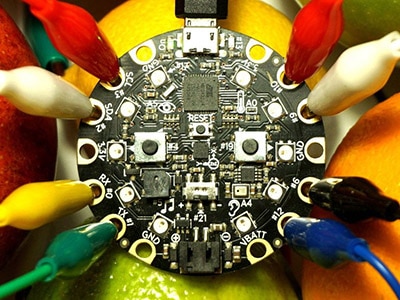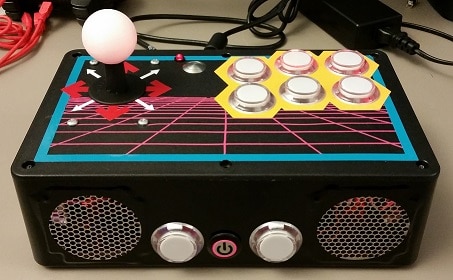Raspberry Pi Pico and LED Arcade Button MIDI Controller
2025-06-13 | By Adafruit Industries
License: See Original Project 3D Printing Raspberry Pi MCU
Courtesy of Adafruit
Guide by Ruiz Brothers and Liz Clark
Overview
DIY MIDI Controller
Build your own CircuitPython powered MIDI controller! This "MIDI fighter"-like controller features 16 arcade buttons with built-in LEDs, an OLED screen and joystick. Play drums, synthesizers or anything MIDI related! All of the electronics are housed in a snap-fit 3D printed case.
Buttons and LEDs
The Raspberry Pi Pico has plenty of GPIO for connecting 4x4 buttons. The AW9525 GPIO expander / LED driver powers the LEDs and connects to the Raspberry Pi Pico over I2C.
The LEDs light up when the buttons are pressed and stay lit until released. Awesome!
Edit MIDI on the Fly
This MIDI controller's special sauce is the ability to change and save MIDI notes directly on the device. This allows quick MIDI notes remapping. Perfect for crafting your own kits and setups for performances.
Intuitive UI/UX
The OLED screen shows the 16 buttons as little circles with numbers. The numbers are the MIDI notes assigned to each button. Use the joystick to select a button and edit the MIDI note. In edit mode, the button will blink the LED, letting you know it's been activated. While in edit mode, the buttons can be pressed to compare MIDI notes.
Kickstand Handle
Lunchbox vibes? Yes! The handle is 3d printed, print-in-place, with no support material. Can you handle it? It also works great as a kickstand to prop up the case.
Prerequisite Guides
Take a moment to walk through the following guides:
Parts from Adafruit
List of parts required for this build.
1 x Panel Mount Extension USB Cable - Micro B Male to Micro B Female
1 x Silicone Cover Stranded-Core Ribbon Cable - 10 Wire 1 Meter Long - 28AWG Black
1 x M2 Hardware Kit
Hardware List
Screws, nuts, and standoffs used in this build.
Handle
4x M3 x 10mm long screws
USB Extension Cable
2x M3 x 10mm long screws
2x M3 locknuts
OLED
4x M2.5 x 12mm long screws
4x M2.5 nuts
5-way navigation PCB0
2x M3 x 4mm long screws
PCB Mount
4x M3 x 12mm long FF standoffs
4x M2.5 x 8mm long FF standoffs
4x M2 x 6mm long FF standoffs
8x M3 x 6mm long screws
8x M2.5 x 4mm long screws
8x M2 x 4mm long screws
Author Credits
CAD by Noe Ruiz and Code by Liz Clark.
Inspired by MIDI Fighter by DJTechTools
Installing CircuitPython
CircuitPython is a derivative of MicroPython designed to simplify experimentation and education on low-cost microcontrollers. It makes it easier than ever to get prototyping by requiring no upfront desktop software downloads. Simply copy and edit files on the CIRCUITPY drive to iterate.
CircuitPython QuickStart
Follow this step-by-step to quickly get CircuitPython working on your board.
Download the latest version of CircuitPython for the Raspberry Pi Pico from circuitpython.org
Click the link above and download the latest UF2 file.
Download and save it to your desktop (or wherever is handy).
Start with your Pico unplugged from USB. Hold down the BOOTSEL button, and while continuing to hold it (don't let go!), plug the Pico into USB. Continue to hold the BOOTSEL button until the RPI-RP2 drive appears!
If the drive does not appear, unplug your Pico, and go through the above process again.
A lot of people end up using charge-only USB cables and it is very frustrating! So, make sure you have a USB cable you know is good for data sync.
You will see a new disk drive appear called RPI-RP2.
Drag the adafruit_circuitpython_etc.uf2 file to RPI-RP2.
The RPI-RP2 drive will disappear, and a new disk drive called CIRCUITPY will appear.
That's it, you're done! :)
Flash Resetting UF2
If your Pico ever gets into a really weird state and doesn't even show up as a disk drive when installing CircuitPython, try installing this 'nuke' UF2 which will do a 'deep clean' on your Flash Memory. You will lose all the files on the board, but at least you'll be able to revive it! After nuking, re-install CircuitPython
Coding the Raspberry Pi Pico MIDI Controller
Installing the CircuitPython Library Bundle
We're constantly updating and improving our libraries, so we don't (at this time) ship our CircuitPython boards with the full library bundle. Instead, you can find example code in the guides for your board that depends on external libraries. Some of these libraries may be available from us at Adafruit, some may be written by community members!
Either way, as you start to explore CircuitPython, you'll want to know how to get libraries on board.
You can grab the latest Adafruit CircuitPython Bundle release by clicking the button below.
Click for the Latest Adafruit CircuitPython Library Bundle Release
Once you've finished setting up your Raspberry Pi Pico with CircuitPython, you can add the libraries to the lib folder of the Pico's CIRCUITPY drive which should appear when the board is plugged into your computer via USB. Copy these folders:
adafruit_bus_device
adafruit_display_shapes
adafruit_display_text
adafruit_midi
adafruit_register
And these files:
adafruit_aw9523.mpy
adafruit_ssd1327.mpy
simpleio.mpy
To the CIRCUITPY flash drive /lib directory (create the directory if it doesn't exist).
Then, you can click on the Download: Project Zip link in the window below to download the code file.
# SPDX-FileCopyrightText: 2021 Liz Clark for Adafruit Industries
#
# SPDX-License-Identifier: MIT
import time
import board
import i2cdisplaybus
import displayio
import terminalio
import adafruit_aw9523
import busio
import adafruit_ssd1327
import digitalio
from adafruit_display_text import label
from adafruit_display_shapes.circle import Circle
from adafruit_display_shapes.rect import Rect
import usb_midi
import adafruit_midi
from adafruit_midi.note_on import NoteOn
from adafruit_midi.note_off import NoteOff
displayio.release_displays()
# i2c setup, higher frequency for display refresh
i2c = busio.I2C(board.GP1, board.GP0, frequency=1000000)
# i2c display setup
display_bus = i2cdisplaybus.I2CDisplayBus(i2c, device_address=0x3D)
# i2c AW9523 GPIO expander setup
aw = adafruit_aw9523.AW9523(i2c)
# MIDI setup as MIDI out device
midi = adafruit_midi.MIDI(midi_out=usb_midi.ports[1], out_channel=0)
# display dimensions
WIDTH = 128
HEIGHT = 128
# display setup
display = adafruit_ssd1327.SSD1327(display_bus, width=WIDTH, height=HEIGHT, brightness=0.01)
# main display group, shows default GUI menu
splash = displayio.Group()
# group for circle icons
circle_group = displayio.Group()
# group for text labels on circles
text_group = displayio.Group()
# list of circle positions
spots = (
(16, 16),
(48, 16),
(80, 16),
(112, 16),
(16, 48),
(48, 48),
(80, 48),
(112, 48),
(16, 80),
(48, 80),
(80, 80),
(112, 80),
(16, 112),
(48, 112),
(80, 112),
(112, 112),
)
# creating the circles & pulling in positions from spots
for spot in spots:
circle = Circle(x0=spot[0], y0=spot[1], r=14, fill=0x888888)
# adding circles to their display group
circle_group.append(circle)
# square to show position on menu
rect = Rect(0, 0, 33, 33, fill=None, outline=0x00FF00, stroke=3)
splash.append(circle_group)
splash.append(rect)
# strings and positions for the MIDI note text labels
texts = [
{'num': "60", 'pos': (12, 16)},
{'num': "61", 'pos': (44, 16)},
{'num': "62", 'pos': (76, 16)},
{'num': "63", 'pos': (108, 16)},
{'num': "64", 'pos': (12, 48)},
{'num': "65", 'pos': (44, 48)},
{'num': "66", 'pos': (76, 48)},
{'num': "67", 'pos': (108, 48)},
{'num': "68", 'pos': (12, 80)},
{'num': "69", 'pos': (44, 80)},
{'num': "70", 'pos': (76, 80)},
{'num': "71", 'pos': (108, 80)},
{'num': "72", 'pos': (12, 112)},
{'num': "73", 'pos': (44, 112)},
{'num': "74", 'pos': (76, 112)},
{'num': "75", 'pos': (108, 112)},
]
text_labels = []
for text in texts:
text_area = label.Label(terminalio.FONT, text=text['num'], color=0xFFFFFF)
text_area.x = text['pos'][0]
text_area.y = text['pos'][1]
text_labels.append(text_area)
text_group.append(text_area)
splash.append(text_group)
# secondary display group, shows large circle when button is selected
big_splash = displayio.Group()
# large circle to fill display
big_circle = Circle(x0=64, y0=64, r=62, fill=0x888888)
big_splash.append(big_circle)
# large text to fill circle
big_text = label.Label(terminalio.FONT, text=' ', color=0xFFFFFF)
big_text.x = 43
big_text.y = 62
big_text.scale = 4
big_splash.append(big_text)
# array for LEDs on AW9523
leds = []
led_pins = [0, 1, 2, 3, 4, 5, 6, 7, 8, 9, 10, 11, 12, 13, 14, 15]
# setup to create the AW9523 outputs for LEDs
for led in led_pins:
led_pin = aw.get_pin(led)
led_pin.direction = digitalio.Direction.OUTPUT
leds.append(led_pin)
# button pins, all pins in order skipping GP15
note_pins = [board.GP7, board.GP8, board.GP9, board.GP10, board.GP11,
board.GP12, board.GP13, board.GP14, board.GP16, board.GP17,
board.GP18, board.GP19, board.GP20, board.GP21, board.GP22, board.GP26]
note_buttons = []
for pin in note_pins:
note_pin = digitalio.DigitalInOut(pin)
note_pin.direction = digitalio.Direction.INPUT
note_pin.pull = digitalio.Pull.UP
note_buttons.append(note_pin)
# note states
note0_pressed = False
note1_pressed = False
note2_pressed = False
note3_pressed = False
note4_pressed = False
note5_pressed = False
note6_pressed = False
note7_pressed = False
note8_pressed = False
note9_pressed = False
note10_pressed = False
note11_pressed = False
note12_pressed = False
note13_pressed = False
note14_pressed = False
note15_pressed = False
# array of note states
note_states = [note0_pressed, note1_pressed, note2_pressed, note3_pressed,
note4_pressed, note5_pressed, note6_pressed, note7_pressed,
note8_pressed, note9_pressed, note10_pressed, note11_pressed,
note12_pressed, note13_pressed, note14_pressed, note15_pressed]
# pins for 5-way switch
select = digitalio.DigitalInOut(board.GP6)
up = digitalio.DigitalInOut(board.GP5)
down = digitalio.DigitalInOut(board.GP4)
left = digitalio.DigitalInOut(board.GP3)
right = digitalio.DigitalInOut(board.GP2)
# array for 5-way switch
joystick = [select, up, down, left, right]
for joy in joystick:
joy.direction = digitalio.Direction.INPUT
joy.pull = digitalio.Pull.UP
# states for 5-way switch
select_state = None
up_state = None
down_state = None
left_state = None
right_state = None
midi_state = None
# coordinates for navigating main GUI
select_x = [0, 32, 64, 96]
select_y = [0, 32, 64, 96]
# y coordinate for 5-way switch navigation
y_pos = 0
# x coordinate for 5-way switch navigation
x_pos = 0
sub_state = False
# default midi number
midi_num = 60
# default MIDI button
button_num = 0
# default MIDI button position
button_pos = 0
# check for blinking LED
led_check = None
# time.monotonic() device
clock = time.monotonic()
# coordinates for tracking location of 5-way switch
up_scroll = 0
down_scroll = 0
left_scroll = 0
right_scroll = 0
switch_coordinates = [(0, 0), (1, 0), (2, 0), (3, 0),
(0, 1), (1, 1), (2, 1), (3, 1),
(0, 2), (1, 2), (2, 2), (3, 2),
(0, 3), (1, 3), (2, 3), (3, 3)]
# array of default MIDI notes
midi_notes = [60, 61, 62, 63, 64, 65, 66, 67, 68, 69, 70, 71, 72, 73, 74, 75]
# show main display GUI
display.root_group = splash
while True:
# debouncing for 5-way switch positions
if up.value and up_state == "pressed":
print("Button pressed.")
up_state = None
if down.value and down_state == "pressed":
print("Button pressed.")
down_state = None
if left.value and left_state == "pressed":
print("Button pressed.")
left_state = None
if right.value and right_state == "pressed":
print("Button pressed.")
right_state = None
if select.value and select_state == "pressed":
print("Button pressed.")
select_state = None
# MIDI input
for i in range(16):
buttons = note_buttons[i]
# if button is pressed...
if not buttons.value and note_states[i] is False:
# send the MIDI note and light up the LED
midi.send(NoteOn(midi_notes[i], 120))
note_states[i] = True
leds[i].value = True
# if the button is released...
if buttons.value and note_states[i] is True:
# stop sending the MIDI note and turn off the LED
midi.send(NoteOff(midi_notes[i], 120))
note_states[i] = False
leds[i].value = False
# if we're on the main GUI page
if not sub_state:
# if you press up on the 5-way switch...
if not up.value and up_state is None:
up_state = "pressed"
# track the switch's position
up_scroll -= 1
if up_scroll < 0:
up_scroll = 3
y_pos = up_scroll
down_scroll = up_scroll
# if you press down on the 5-way switch...
if not down.value and down_state is None:
down_state = "pressed"
# track the switch's position
down_scroll += 1
if down_scroll > 3:
down_scroll = 0
y_pos = down_scroll
up_scroll = down_scroll
# if you press left on the 5-way switch...
if not left.value and left_state is None:
# print("scroll", down_scroll)
left_state = "pressed"
# track the switch's position
left_scroll -= 1
if left_scroll < 0:
left_scroll = 3
x_pos = left_scroll
right_scroll = left_scroll
# if you press right on the 5-way switch...
if not right.value and right_state is None:
# print("scroll", down_scroll)
right_state = "pressed"
# track the switch's position
right_scroll += 1
if right_scroll > 3:
right_scroll = 0
x_pos = right_scroll
left_scroll = right_scroll
# update square's position on the GUI
rect.y = select_y[y_pos]
rect.x = select_x[x_pos]
# update the currently highlighted button on the GUI
for coords in switch_coordinates:
if x_pos == coords[0] and y_pos == coords[1]:
button_pos = switch_coordinates.index(coords)
# print(button_pos)
button_num = text_labels[button_pos].text
# if you press select on the 5-way switch...
if not select.value and select_state is None:
select_state = "pressed"
# grab the selected button's MIDI note
midi_num = int(button_num)
# change into the secondary GUI menu
sub_state = True
# if an arcade button is selected to change the MIDI note...
if sub_state:
# display the secondary GUI menu
display.root_group = big_splash
# display the selected button's MIDI note
big_text.text = str(midi_num)
# blink the selected button's LED without pausing the loop
if (time.monotonic() > (clock + 1)) and led_check is None:
leds[button_pos].value = True
led_check = True
clock = time.monotonic()
if (time.monotonic() > (clock + 1)) and led_check is True:
leds[button_pos].value = False
led_check = None
clock = time.monotonic()
# blocks the MIDI number from being set above 128
if midi_num >= 128:
midi_num = 128
# blocks the MIDI number from being set below 0
if midi_num <= 0:
midi_num = 0
# if you press right on the 5-way switch...
if not right.value and right_state is None:
# increase the MIDI number
midi_num += 1
right_state = "pressed"
# if you press up on the 5-way switch...
if not up.value and up_state is None:
# increase the MIDI number
midi_num += 1
up_state = "pressed"
# if you press left on the 5-way switch...
if not left.value and left_state is None:
# decrease the MIDI number
midi_num -= 1
left_state = "pressed"
# if you press down on the 5-way switch...
if not down.value and down_state is None:
# decrease the MIDI number
midi_num -= 1
down_state = "pressed"
# update arcade button's MIDI note
# allows you to check note while you're adjusting it
midi_notes[button_pos] = midi_num
# if you press select on the 5-way switch...
if not select.value and select_state is None:
select_state = "pressed"
# change back to main menu mode
sub_state = False
# update new MIDI number text label
text_labels[button_pos].text = str(midi_num)
# show main GUI display
display.root_group = splash
# turn off blinking LED
leds[button_pos].value = False
Review
Make sure you've followed these steps:
Loaded all the required library files and directories into the CIRCUITPY /lib directory
Copied code.py to the main (root) directory of the CIRCUITPY drive
Your Raspberry Pi Pico CIRCUITPY drive should look like this after you load the libraries and code.py file:
CircuitPython Code Walkthrough
Import the Libraries
First, the CircuitPython libraries are imported.
import time import board import displayio import i2cdisplaybus import terminalio import adafruit_aw9523 import busio import adafruit_ssd1327 import digitalio from adafruit_display_text import label from adafruit_display_shapes.circle import Circle from adafruit_display_shapes.rect import Rect import usb_midi import adafruit_midi from adafruit_midi.note_on import NoteOn from adafruit_midi.note_off import NoteOff
I2C and MIDI Setup
I2C is setup to use the Pico's GP0 and GP1 pins. You have two I2C devices in this project: the Grayscale 1.5" 128x128 OLED Display and the AW9523 GPIO Expander and LED Driver.
midi is also setup to act as a USB MIDI output device. midi_out sends notes out from the device.
# i2c setup, higher frequency for display refresh i2c = busio.I2C(board.GP1, board.GP0, frequency=1000000) # i2c display setup display_bus = i2cdisplaybus.I2CDisplayBus(i2c, device_address=0x3D) # i2c AW9523 GPIO expander setup aw = adafruit_aw9523.AW9523(i2c) # MIDI setup as MIDI out device midi = adafruit_midi.MIDI(midi_out=usb_midi.ports[1], out_channel=0)
Display Setup
This project utilizes a graphical user interface (GUI) to let you change the MIDI note numbers assigned to each of the arcade buttons. Each button is represented on the display as a circle. The code uses the Circle object from the adafruit_display_shapes library to easily draw circles on the display without having to import a bitmap.
spots hold the list of coordinates for each of the circles and the for statement creates each circle and assigns them to the correct coordinate.
A rectangle is also created using the Rect object from the adafruit_display_shapes library. This rectangle is used to highlight the currently selected circle on the display.
# display dimensions
WIDTH = 128
HEIGHT = 128
# display setup
display = adafruit_ssd1327.SSD1327(display_bus, width=WIDTH, height=HEIGHT, brightness = 0.01)
# main display group, shows default GUI menu
splash = displayio.Group()
# group for circle icons
circle_group = displayio.Group()
# group for text labels on circles
text_group = displayio.Group()
# list of circle positions
spots = (
(16, 16),
(48, 16),
(80, 16),
(112, 16),
(16, 48),
(48, 48),
(80, 48),
(112, 48),
(16, 80),
(48, 80),
(80, 80),
(112, 80),
(16, 112),
(48, 112),
(80, 112),
(112, 112),
)
# creating the circles & pulling in positions from spots
for spot in spots:
circle = Circle(x0=spot[0], y0=spot[1], r=14, fill=0x888888)
# adding circles to their display group
circle_group.append(circle)
# square to show position on menu
rect = Rect(0, 0, 33, 33, fill=None, outline=0x00FF00, stroke = 3)
splash.append(circle_group)
splash.append(rect)MIDI Note Labels
Each circle has text that shows the currently assigned MIDI note number for each arcade button. This information is stored in texts along with the coordinates for each string's location. The for statement creates each text object, pulling this information from texts, and stores them in the text_labels array.
# strings and positions for the MIDI note text labels
texts = [
{'num': "60", 'pos': (12, 16)},
{'num': "61", 'pos': (44, 16)},
{'num': "62", 'pos': (76, 16)},
{'num': "63", 'pos': (108, 16)},
{'num': "64", 'pos': (12, 48)},
{'num': "65", 'pos': (44, 48)},
{'num': "66", 'pos': (76, 48)},
{'num': "67", 'pos': (108, 48)},
{'num': "68", 'pos': (12, 80)},
{'num': "69", 'pos': (44, 80)},
{'num': "70", 'pos': (76, 80)},
{'num': "71", 'pos': (108, 80)},
{'num': "72", 'pos': (12, 112)},
{'num': "73", 'pos': (44, 112)},
{'num': "74", 'pos': (76, 112)},
{'num': "75", 'pos': (108, 112)},
]
text_labels = []
for text in texts:
text_area = label.Label(terminalio.FONT, text=text['num'], color=0xFFFFFF)
text_area.x = text['pos'][0]
text_area.y = text['pos'][1]
text_labels.append(text_area)
text_group.append(text_area)
splash.append(text_group)Secondary GUI Menu
In addition to the main GUI, there is a secondary GUI. When you select an arcade button's MIDI note to edit, the display shows a large circle with large text showing the MIDI note number that you're editing. This secondary GUI is stored in big_splash.
# secondary display group, shows large circle when button is selected big_splash = displayio.Group() # large circle to fill display big_circle = Circle(x0=64, y0=64, r=62, fill=0x888888) big_splash.append(big_circle) # large text to fill circle big_text = label.Label(terminalio.FONT, text=' ', color=0xFFFFFF) big_text.x = 43 big_text.y = 62 big_text.scale = 4 big_splash.append(big_text)
LEDs with the AW9523
The arcade button's LEDs are controlled with the AW9523 GPIO expander. The I/O of the AW9523 is accessed with aw.get_pin(pin_number). The pin numbers are stored in the led_pins array and the for statement sets up the pins to be outputs.
# array for LEDs on AW9523
leds = []
led_pins = [0, 1, 2, 3, 4, 5, 6, 7, 8, 9, 10, 11, 12, 13, 14, 15]
# setup to create the AW9523 outputs for LEDs
for led in led_pins:
led_pin = aw.get_pin(led)
led_pin.direction = digitalio.Direction.OUTPUT
leds.append(led_pin)Arcade Button Pins
The pins used for the arcade buttons are stored in the note_pins array. They are setup to be digital inputs in the for statement and are then stored in the note_buttons array.
Each arcade button has a state setup for debouncing. These states are stored in the note_states array.
# button pins, all pins in order skipping GP15
note_pins = [board.GP7, board.GP8, board.GP9, board.GP10, board.GP11,
board.GP12, board.GP13, board.GP14, board.GP16, board.GP17,
board.GP18, board.GP19, board.GP20, board.GP21, board.GP22, board.GP26]
note_buttons = []
for pin in note_pins:
note_pin = digitalio.DigitalInOut(pin)
note_pin.direction = digitalio.Direction.INPUT
note_pin.pull = digitalio.Pull.UP
note_buttons.append(note_pin)
# note states
note0_pressed = False
note1_pressed = False
note2_pressed = False
note3_pressed = False
note4_pressed = False
note5_pressed = False
note6_pressed = False
note7_pressed = False
note8_pressed = False
note9_pressed = False
note10_pressed = False
note11_pressed = False
note12_pressed = False
note13_pressed = False
note14_pressed = False
note15_pressed = False
# array of note states
note_states = [note0_pressed, note1_pressed, note2_pressed, note3_pressed,
note4_pressed, note5_pressed, note6_pressed, note7_pressed,
note8_pressed, note9_pressed, note10_pressed, note11_pressed,
note12_pressed, note13_pressed, note14_pressed, note15_pressed]5-Way Navigation Switch
The GUI is navigated with a 5-way switch. This allows you to move in all directions around the screen and select the arcade button that you want to edit. The digital pins for the 5-way switch are stored in the joystick array and are setup as inputs in the for statement.
# pins for 5-way switch
select = digitalio.DigitalInOut(board.GP6)
up = digitalio.DigitalInOut(board.GP5)
down = digitalio.DigitalInOut(board.GP4)
left = digitalio.DigitalInOut(board.GP3)
right = digitalio.DigitalInOut(board.GP2)
# array for 5-way switch
joystick = [select, up, down, left, right]
for joy in joystick:
joy.direction = digitalio.Direction.INPUT
joy.pull = digitalio.Pull.UPState Machines
There are a few state machines used in the code. Each pin for the 5-way switch has a state for debouncing. The other states' functionality is commented below.
# states for 5-way switch select_state = None up_state = None down_state = None left_state = None right_state = None midi_state = None # coordinates for navigating main GUI select_x = [0, 32, 64, 96] select_y = [0, 32, 64, 96] # y coordinate for 5-way switch navigation y_pos = 0 # x coordinate for 5-way switch navigation x_pos = 0 sub_state = False # default midi number midi_num = 60 # default MIDI button button_num = 0 # default MIDI button position button_pos = 0 # check for blinking LED led_check = None # time.monotonic() device clock = time.monotonic()
GUI Navigation Setup
The navigation for the GUI works by counting the number of times each directional input from the 5-way switch is pressed. The combinations of these counts are stored in the switch_coordinates array to act as x and y coordinates on the GUI. It's helpful to think of the arcade buttons as a 4x4 grid.
# coordinates for tracking location of 5-way switch
up_scroll = 0
down_scroll = 0
left_scroll = 0
right_scroll = 0
switch_coordinates = [(0, 0), (1, 0), (2, 0), (3, 0), (0, 1), (1, 1), (2, 1), (3, 1), (0, 2),
(1, 2), (2, 2), (3, 2), (0, 3), (1, 3), (2, 3), (3, 3)]MIDI Note Array
The midi_notes array holds the default MIDI notes that are assigned to the arcade buttons. If you want to change the MIDI notes that are loaded after powering the MIDI Fighter, you'll want to edit this array.
# array of default MIDI notes midi_notes = [60, 61, 62, 63, 64, 65, 66, 67, 68, 69, 70, 71, 72, 73, 74, 75]
The Loop
Switch Debouncing
The loop begins by debouncing the five inputs of the 5-way switch.
while True:
# debouncing for 5-way switch positions
if up.value and up_state == "pressed":
print("Button pressed.")
up_state = None
if down.value and down_state == "pressed":
print("Button pressed.")
down_state = None
if left.value and left_state == "pressed":
print("Button pressed.")
left_state = None
if right.value and right_state == "pressed":
print("Button pressed.")
right_state = None
if select.value and select_state == "pressed":
print("Button pressed.")
select_state = NoneMIDI Input
The arcade buttons send their assigned MIDI note number out with a MIDI NoteOn message when they are pressed. Additionally, when you press an arcade button, its LED lights up with the AW9523. When the arcade button is released, a NoteOff message is sent, and the LED is turned off.
# MIDI input
for i in range(16):
buttons = note_buttons[i]
# if button is pressed...
if not buttons.value and note_states[i] is False:
# send the MIDI note and light up the LED
midi.send(NoteOn(midi_notes[i], 120))
note_states[i] = True
leds[i].value = True
# if the button is released...
if buttons.value and note_states[i] is True:
# stop sending the MIDI note and turn off the LED
midi.send(NoteOff(midi_notes[i], 120))
note_states[i] = False
leds[i].value = FalseMain GUI Navigation
The main GUI is navigated using the 5-way switch. Every time you press up, down, left or right, the values of up_scroll, down_scroll, left_scroll or right_scroll are updated with a count between 0 and 3. These values are used as coordinates to track where you are on the GUI.
y_pos and x_pos also hold these values and are used as array indexes to update the highlighting square's position on the GUI.
# if we're on the main GUI page
if not sub_state:
# if you press up on the 5-way switch...
if not up.value and up_state is None:
up_state = "pressed"
# track the switch's position
up_scroll -= 1
if up_scroll < 0:
up_scroll = 3
y_pos = up_scroll
down_scroll = up_scroll
# if you press down on the 5-way switch...
if not down.value and down_state is None:
down_state = "pressed"
# track the switch's position
down_scroll += 1
if down_scroll > 3:
down_scroll = 0
y_pos = down_scroll
up_scroll = down_scroll
# if you press left on the 5-way switch...
if not left.value and left_state is None:
# print("scroll", down_scroll)
left_state = "pressed"
# track the switch's position
left_scroll -= 1
if left_scroll < 0:
left_scroll = 3
x_pos = left_scroll
right_scroll = left_scroll
# if you press right on the 5-way switch...
if not right.value and right_state is None:
# print("scroll", down_scroll)
right_state = "pressed"
# track the switch's position
right_scroll += 1
if right_scroll > 3:
right_scroll = 0
x_pos = right_scroll
left_scroll = right_scroll
# update square's position on the GUI
rect.y = select_y[y_pos]
rect.x = select_x[x_pos]Track the Button
In order to keep track of which button on the GUI is highlighted, the x_pos and y_pos values are compared to the switch_coordinates array to track which button is highlighted on the screen. This is how that button's value can then be affected in the secondary GUI.
button_num is used to track the MIDI note number for the currently selected button.
# update the currently highlighted button on the GUI
for coords in switch_coordinates:
if x_pos == coords[0] and y_pos == coords[1]:
button_pos = switch_coordinates.index(coords)
# print(button_pos)
button_num = text_labels[button_pos].textSelecting a Button to Edit
When you have navigated to your chosen arcade button's position, you can press select on the 5-way switch to enter the editing mode for that button. midi_num grabs the highlighted button's MIDI note number so that you'll be able to edit and update that number.
# if you press select on the 5-way switch...
if not select.value and select_state is None:
select_state = "pressed"
# grab the selected button's MIDI note
midi_num = int(button_num)
# change into the secondary GUI menu
sub_state = TrueSecondary GUI: Edit the Arcade Button's MIDI Note Number
When you enter the editing mode, the secondary GUI is displayed. Your selected button's LED will also blink on and off until you exit this mode. The blinking is done using time.monotonic() so that it doesn't interrupt anything else happening in the loop.
# if an arcade button is selected to change the MIDI note...
if sub_state:
# display the secondary GUI menu
display.root_group = big_splash
# display the selected button's MIDI note
big_text.text = midi_num
# blink the selected button's LED without pausing the loop
if (time.monotonic() > (clock + 1)) and led_check is None:
leds[button_pos].value = True
led_check = True
clock = time.monotonic()
if (time.monotonic() > (clock + 1)) and led_check is True:
leds[button_pos].value = False
led_check = None
clock = time.monotonic()MIDI Note Number Range
A MIDI note range is setup so that you don't go below 0 or above 128.
# blocks the MIDI number from being set above 128
if midi_num >= 128:
midi_num = 128
# blocks the MIDI number from being set below 0
if midi_num <= 0:
midi_num = 0Adjusting the MIDI Note
The MIDI note number can be increased by pressing up or right with the 5-way switch and decreased by pressing down or left with the 5-way switch. The value of midi_num is either increased or decreased by 1 depending on the input.
# if you press right on the 5-way switch...
if not right.value and right_state is None:
# increase the MIDI number
midi_num += 1
right_state = "pressed"
# if you press up on the 5-way switch...
if not up.value and up_state is None:
# increase the MIDI number
midi_num += 1
up_state = "pressed"
# if you press left on the 5-way switch...
if not left.value and left_state is None:
# decrease the MIDI number
midi_num -= 1
left_state = "pressed"
# if you press down on the 5-way switch...
if not down.value and down_state is None:
# decrease the MIDI number
midi_num -= 1
down_state = "pressed"Update the MIDI Note
The value of the selected arcade button's MIDI note is adjusted in real time. This allows you to play the note while you're adjusting to make sure it's the correct note.
# update arcade button's MIDI note
# allows you to check note while you're adjusting it
midi_notes[button_pos] = midi_numSave the New MIDI Note
After deciding on your MIDI note, you can press select again on the 5-way switch to save your choice. This updates the text label on the main GUI, stops the LED from blinking and brings you back to the main GUI on the display.
# if you press select on the 5-way switch...
if not select.value and select_state is None:
select_state = "pressed"
# change back to main menu mode
sub_state = False
# update new MIDI number text label
text_labels[button_pos].text = midi_num
# show main GUI display
display.root_group = splash
# turn off blinking LED
leds[button_pos].value = FalseCircuit Diagram
The diagram below provides a visual reference for wiring of the components. This diagram was created using the software package Fritzing.
Adafruit Library for Fritzing
Use Adafruit's Fritzing parts library to create circuit diagrams for your projects. Download the library or just grab individual parts. Get the library and parts from GitHub - Adafruit Fritzing Parts.
STEMMA QT Connections
The following components are connected via STEMMA QT cables.
Raspberry Pi Pico – 1.5" OLED
1.5" OLED – AW9523 LED Driver
5-way navigation switch
The 5-way navigation switch is connected to the following pins on the Raspberry Pi Pico.
Ground – Ground
Select – GP6
Up – GP2
Down – GP3
Left – GP4
Right – GP5
Button Switches
The switches from the buttons are connected to the following pins on the Raspberry Pi Pico.
Button 1 – GP7
Button 2 – GP8
Button 3 – GP9
Button 4 – GP10
Button 5 – GP11
Button 6 – GP12
Button 7 – GP13
Button 8 – GP14
Button 9 – GP16
Button 10 – GP17
Button 11 – GP18
Button 12 – GP19
Button 13 – GP20
Button 14 – GP21
Button 15 – GP22
Button 16 – GP26
Button LEDs
The LEDs from the buttons are connected to the following pins on the AW9523 LED Driver.
Button 1 – Pin 0
Button 2 – Pin 1
Button 3 – Pin 2
Button 4 – Pin 3
Button 5 – Pin 4
Button 6 – Pin 5
Button 7 – Pin 6
Button 8 – Pin 7
Button 9 – Pin 8
Button 10 – Pin 9
Button 11 – Pin 10
Button 12 – Pin 11
Button 13 – Pin 12
Button 14 – Pin 13
Button 15 – Pin 14
Button 16 – Pin 15
3D Printing
CAD Files
STL files for 3D printing are oriented to print "as-is" on FDM style machines. Parts are designed to 3D print without any support material. Original design source may be downloaded using the links below.
CAD Parts List
List of the 3D printed parts.
case-top.stl
case-frame.stl
case-bottom.stl
case-handle.stl
PCB-mount.stl
5way-switch-pcb.stl
window-print-blank.stl
window-printed-midi-logo.stl
case-bottom-window.stl
Opens in the web browser to preview 3D models. More download options available in the preview page.
Includes a STEP and Fusion 360 Archive.
Grab just the STL files for 3D printing.
Window Options
The top cover is designed to have a window. This allows you to peek through and see the Raspberry Pi Pico. The window can be 3D printed using transparent filament.
Have fun with this! Add your own text, logo, or stickers / vinyl decals. Personalize it, make it yours.
Optionally, the window can be made from acrylic using a laser cutter or CNC mill.
Install Window
The window features a lip to prevent it from being pressed all the way through the cut out in the top cover.
The window is installed through the bottom side of the top cover. It should have a tight fit.
Optionally glue in place to permanently secure to the top cover.
Install Handle to Frame
Use the following hardware to secure the handle to the frame.
4x M3 x 10mm screws
4x M3 locknuts
Handle Kickstand
The handle features an angled surface for propping up the case. Reference the image for the correct placement of the handle. Use the USB opening on the side of the frame as an indicator for the correct orientation.
Secure Handle to Frame
Insert the M3 screws through the mounting holes in the hinges. Then, insert the screws through the holes on the side of the frame. Install and fasten the locknuts onto the screws. Use pliers to tightly secure the screw and nuts.
Install Bottom Cover to Frame
The bottom cover snap fits onto the frame. The bottom cover features snap fit clips that are designed to lock onto the edges inside the frame.
Reference the image for the correct orientation.
Fusion 360 CAD Tutorial
Taking a look at designing a hinged handle that can be 3d printed in place with no supports. The design features a handle that can rotate 180 degrees. This handle is a part of the enclosure for a MIDI controller. Driven with user parameters, the handle can be customized to fit any project.
PCB Mount Assembly
Hardware for PCB Mount
Use the following hardware for assembling the PCB mount.
4x M3 x 12mm long FF standoffs
4 x M2.5mm x 8mm long FF standoffs
4x M2 x 6mm long FF standoffs
8x M3 x 6mm screws
8x M2 x 4mm screws
8x M2.5 x 4mm screws
Install M3 hardware
Insert M3 screws through the mounting holes on the outer perimeter of the PCB mount. Fasten the M3 standoffs onto the thread of the screw.
Install M2 Hardware
Insert M2 screws through the mounting holes that are near the M3 standoffs. Fasten the M2 standoffs onto the threads of the screws.
Install M2.5 Hardware
Flip the PCB over and insert the M2.5 screws through the remaining mounting holes. Fasten the M2.5 standoffs onto the threads of the screws. The M2.5 standoffs should be facing the opposite side. Reference the image for correct placement.
Assembled PCB Mount
Double check the standoffs are tightly fastened and installed in the correct mounting holes. Reference the images, click the thumbnail to enlarge.
Wiring the 5-Way Navigation Switch
Wires for 5-Way Nav Switch
Choose the method to switch you'd like to wire the 5-way navigation switch. Provided is an STL to 3D print the PCB or you can optionally send the PCB to a fab service.
Use a 6-wire ribbon cable, 114mm long.
Download 5-Way Navigation Switch PCB files
Install 5-Way Switch to PCB
Line up the pins of the switch with the holes in the PCB. Fit the 5-way navigation switch onto the PCB.
5-Way Navigation Switch Schematic
Reference the schematic to get the correct connections for the pins.
The common ground and center pins are good indicators for wiring. Up, down, left and right are subject to change depending on the switch’s orientation.
The full data sheet is available, and a PDF can be downloaded from here.
Solder Wires to 5-Way Nav Switch PCB
If you're using the PCB, solder the pins of the switch to the PCB. Then, solder the 6-wires from the ribbon cable to the breakout pins on the PCB.
If you're using the 3D printed PCB, solder the wires to the exposed pins from the bottom. Be careful not to melt the plastic.
Soldering 5-Way Switch to Pico
Get ready to solder the 6-wires from the navigation switch to the Raspberry Pi Pico.
If using the 3D printed pcb, double check the wires are soldered to the correct pins of the 5-way switch.
Solder Wires to 5-Way Switch
Solder the 6-wires from the navigation switch to the bottom of the Raspberry Pi Pico PCB. Reference the pins below.
Ground – Ground
Select – GP6
Up – GP5
Down – GP4
Left – GP3
Right – GP2
Soldered 5-Way Switch
Double check all of the wires have been properly soldered.
Wiring STEMMA for Pico
STEMMA Wire
Use the STEMMA QT JST SH-4 cable for the Raspberry Pi Pico. This will plug into the OLED display.
Remove the male header pins by cutting them off leaving the cable about 150mm in length.
Use wire strippers to remove a bit of insulation from the tips of each wire. Tin the exposed strands of wire by adding a bit of solder.
Solder STEMMA to Raspberry Pi Pico
Attach the four wires from the STEMMA cable to the bottom of the Raspberry Pi Pico.
Blue wire – GP0
Yellow Wire – GP1
Red Wire – 3V3
Black Wire – GND
Soldered Pico STEMMA cable
Double check the four wires have been properly soldered to the pins on the Raspberry Pi Pico.
Install Buttons
Installing Buttons
Get the 16 buttons ready to panel mount to the top cover. Remove the hex nuts by unscrewing them from the body of each button.
Panel Mount Buttons
Start by installing one button. Insert the body of the button through the hole. While holding it in place, fasten the hex nut onto the button.
To make the wiring easier, ensure all sixteen buttons are orientated the same. This will help keep the wiring tidy as well.
Tightly fasten the hex nuts to secure the buttons to the top cover.
Numbering Buttons for Wiring
Each button will need to wired to the Raspberry Pi Pico and LED Driver. The numbering of the buttons is important and should be planned before wiring.
Take a moment to review the numbering scheme of the buttons. This will help you ensure the buttons are soldered to the correct pins.
Installed Buttons
The first button starts from the top right. The numbering scheme appears reversed because we'll be soldering from the back view of the top cover.
Reference the image for the assigned button numbers.
Wiring Grounds
Ground Wires
All of the switches and LEDs from the buttons will share common ground. In order to do this, we'll need to create several short wires.
Use silicone ribbon wire to create 32 short wires that are approximately 70mm(2.76in) in length.
Use wire strippers to remove a bit of insulation from both ends of each wire. Tin the exposed wire with a bit of solder.
Tinning Pins
Apply a bit of solder to all of the pins on each button. This will make attaching the wires to the pins easier.
Be careful not to melt the buttons with the soldering iron!
First Ground Wires
Attach two wires to the ground pin of the first switch. Reference the markings on the buttons (if they have them).
The pins inside the gray box are the pins for the switch.
The pins outside the gray box are the pins for the LEDs.
Sharing Ground
Each ground connect will need to jump to the next button in the arrangement. Using tweezers can help hold two wires in place while soldering.
Wiring Grounds
Starting with the first button from the top right, proceed to wire from right to left to complete the first row of four buttons.
On the four button, jump to the next row with button #8 and proceed to jump from left to right.
On the fifth button, jump to the next row with button #9 and proceed to share ground from right to left.
On the twelfth button, jump to the last row with button #16. Proceed to share ground from left to right.
Button Switches Shared Ground
Take a moment to double check the wiring and ensure all of the solder joints are solid. Lightly tug on the wires to check if they're secured.
LED and Switch Shared Ground
On button #13 in last row, connect the second ground wire to the ground pin on the LED. Proceed to share ground to all of the button LEDs.
Button LED Ground Wiring
Complete the last row, Button #13 to #16 and connect each going right to left.
Proceed to connect Button #16 to Button #12 going from left to right.
Proceed to connect Button #9 to Button #5 going from right to left.
Proceed to connect Button #8 to Button #4 going from left to right.
The last ground wire connects Button #2 to Button #1.
Once complete, take a moment to review all of the wires.
Wiring Button Switches
Wire Planning
Start planning to wire the switches from all sixteen buttons to the Raspberry Pi Pico. The wires will be soldered to the bottom of the PCB.
Place the Raspberry Pi Pico over the opening in the top cover to reference how long the wires will need to be in order to reach the PCB.
Wires for Switches
Each wire will most likely have a different length of wire. To help keep them organized, use heat shrink tubing, tape or similar to keep sets of wire bundled together.
Here I've created four sets of wires, each set having four wires.
Wiring Buttons 1-4
Solder the wires to buttons 1-4.
Wiring Buttons 5-8
Solder the next set of wires to Buttons 5-8
Wiring Buttons 9-12
Solder the next set of wires to Buttons 9-12.
Wiring Buttons 13-16
Solder the last set of wires to Buttons 13-16.
Once complete, take a moment to review each wire.
Wiring Button LEDs
Wires for LEDs
Time to make wires for connecting the Button LEDs. Create four sets of wire, each set containing four wires.
Wiring LEDs 1-4
Proceed to wire up the LEDs in the first row.
Wiring LEDs 5-8
Proceed to wire up the second row, Buttons 5-8.
Wiring LEDs 9-12
Proceed to wire up the third row, buttons 9-12.
Wiring LEDs 13-16
Proceed to wire up the last row, buttons 13-16.
Once complete, review.
Wiring Button Switches to Pico
Wiring Button LEDs and Switches to Pico
Get ready to solder all of the wires to the bottom of the Raspberry Pi Pico PCB.
Solder Button Switches 1-4
Use a PCB vise or third helping hands to keep the Raspberry Pi Pico PCB secured while soldering.
Solder the switch wires from Button 1-4 to GP7-10.
Button 1 – GP7
Button 2 – GP8
Button 3 – GP9
Button 4 – GP10
Solder Button Switches 5-8
Proceed to wire up the second row of button switches to the Raspberry Pi Pico.
Button 5 – GP11
Button 6 – GP12
Button 7 – GP13
Button 8 – GP14
Do not use GP15 – It's used as the boot select button and should be avoided.
Solder Button Switches to 9-12
Proceed to wire up the third row of button switches to the Raspberry Pi Pico.
Button 9 – GP16
Button 10 – GP17
Button 11 – GP18
Button 12 – GP19
Solder Button Switches 13-16
Proceed to wire up the last row of button switches to the Raspberry Pi Pico.
Button 13 – GP20
Button 14 – GP21
Button 15 – GP22
Button 16 – GP26
Install OLED
Solder Ground to OLED
Secure the OLED to a panavise, PCB vise or third helping hands. Solder the remaining ground wire to the ground pin on the OLED breakout.
Connect STEMMA Cables to OLED
Plug in the STEMMA QT cable from the Raspberry Pi Pico to the left port on the side of the OLED.
Plug in the STEMMA QT / Qwiic JST SH 4-Pin Cable to the right port on the other side of the OLED.
Hardware for OLED
Use the following hardware to secure the OLED to the top cover.
4x M2.5 x 12mm screws
4x M2.5 hex nuts
Install OLED to Top Cover
Place the OLED face down into the top cover. Line up the mounting tabs with the mounting holes in the top cover.
Insert the screws through the holes in the top cover and push them through the mounting holes on the OLED.
Secure OLED
While holding screw in place, insert and fasten an M2.5 hex nut onto the thread of the screw. Only finger tightly the hex nuts to secure the screen. Proceed to install the remaining screws.
The OLED screen is very fragile so be gentle when tightening screws!
Install 5-Way Nav Switch
Install Rubber Nub for 5-Way Nav Switch
Before panel mounting the 5-way navigation switch, install the rubber nubbin for the Joystick (if you'd like, it's optional). It is press fitted over the stem of the joystick and has a snug fit.
Screws for 5-Way Nav Switch
Install the 5-way navigation switch into the top cover. Line up the mounting tabs with the built-in standoffs on the top cover. Use the following screws to secure the 5-way navigation switch.
2x M3 x 4mm screws
Secure 5-Way Nav Switch
Insert and fasten the two M3 x 4mm screws through the mounting tabs on the PCBs.
Install PCB Mount
Installing PCB Mount
Get the PCB mount ready to secure the Raspberry Pi Pico. Use the following screws.
4x M2 x 4mm long screws
Secure Pico to PCB Mount
Carefully place the Raspberry Pi Pico over the M2 standoffs that are secured to the PCB mount. Use the 4x M2 x 4mm long screws to secure the Raspberry Pi Pico to the four M2 standoffs.
Connect USB Extension Cable to Pico
Grab the USB extension cable and connect it to the microUSB port on the Raspberry Pi Pico. It's important to connect these together before securing the PCB mount to the top cover.
Screws for Securing PCB mount to Top Cover
Use the following screws to secure the PCB mount to the top cover.
4x M3 x 4mm long screws
Secure PCB Mount to Top Cover
Position the PCB mount in place and line up the M3 standoffs with the mounting holes in the top cover.
While holding in place, insert and fasten the 4x M3x4mm long screws to secure the PCB mount to the top cover.
Secured PCB Mount
Check the PCB mount is properly secured to the top cover.
Install and Wire LED Driver
Screws for LED Driver
Use the following hardware to secure the LED driver to the PCB mount.
4x M2.5 x 4mm long screws
Secure LED Driver to PCB Mount
Place the LED driver over the remaining M2.5 standoffs.
Insert and fasten 4x M2.5x4mm long screws to secure the LED driver to the PCB mount.
Wire Button LEDs 1-4 to LED Driver
Get ready to solder the LED wires to the LED driver. Make the following connections.
Button 1 – Pin #0
Button 2 – Pin #1
Button 3 – Pin #2
Button 4 – Pin #3
Note: Be careful not to miss Pin 0 – It's on the other side of the board.
Wire Button LEDs 5-8 to LED Driver
Make the following connections.
Button 5 – Pin #4
Button 6 – Pin #5
Button 7 – Pin #6
Button 8 – Pin #7
Wire Button LEDs 9-12 to LED Driver
Make the following connections.
Button 9 – Pin #8
Button 10 – Pin #9
Button 11 – Pin #10
Button 12 – Pin #11
Pins #8-11 are on the other side of the board.
Wire Button LEDs 13-16 to LED Driver
Make the following connections
Button 13 – Pin #12
Button 14 – Pin #13
Button 15 – Pin #14
Button 16 – Pin #15
Connect STEMMA Cable to LED Driver
Lastly, connect the STEMMA cable from the OLED to the STEMMA port on the LED driver.
It just plugs in, isn't STEMMA QT awesome?
Wiring Complete
YES! Congratulations, you've completed the wiring. Take a moment to bask in the glory.
Final Assembly
Secure USB Extension Cable
The USB extension cable is panel mounted to the side of the frame. Use the screws included or use your own (mine are coated in black paint).
M3 x 10mm long screws
Hold the USB extension port in place with your desired orientation. Insert and fasten the two M3 screws while holding the USB port in place.
The stock length of the USB extension cable is just the right length we need – No need to cut or extend, yay!
Close Case
The top cover snap fits onto the frame. Bring the two together and line up the clips with the edges of the frame. Firmly press them together to snap fit the case shut.
Final Build
And there you have it! Your DIY MIDI Controller is assembled and ready for jamming. Congratulations!
Jam Out
With your Raspberry Pi Pico MIDI controller all assembled, you're ready to jam! You can use it with any software that allows MIDI input. Most commonly, you'll use a MIDI controller with music production software such as Reason, Garage Band, FL Studio, Ableton Live, etc.
You could use the MIDI device for recording your own music with MIDI or for playing live. With the MIDI mapping, you can create unique arrangements on the fly without having to go back and forth between software and the device. In a live situation, the added control of the quick mapping opens up a world of possibilities.





